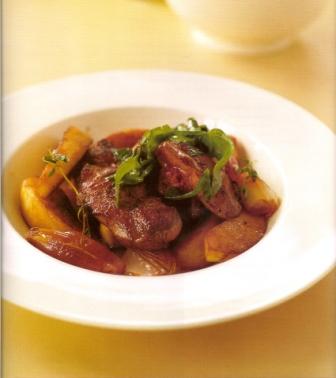Pan-fried Chicken Livers with Apples and Honey
Description
I have loved chicken livers ever since I ate Tony Astle’s classic pan-fried chicken livers at his Parnell restaurant, Antoines. The real trick to cooking chicken livers is to sear them in a hot pan so the outside is almost crisp and the interiors are still pink and moist. This takes a little courage as chicken livers can explode in very hot oil. Don’t be put off though as this dish is delicious with the tart apples and sharp shallots that slightly caramelise in the pan really complementing the rich livers. This dish makes a great starter in the autumn, when apples are at their best.
Method
Peel the shallots and trim well. Pick over the chicken livers, trimming away and discarding all sinew and connective tissue.
Peel the apples and remove the cores. Cut apples into chunky slices. In a large frying pan, melt the butter and add the balsamic vinegar and honey. Keep the temperature low and add the shallots and apples. Cook very slowly until they are soft and golden. Remove the apples and deglaze the pan with the stock. Add the lime zest and juice and simmer for a few minutes to reduce by half. Pour this sauce into a small bowl and put aside.
Add a little extra butter and the thyme to the pan and heat. Cook the chicken livers fairly briskly so they brown nicely but do not dry out.
To serve, return the apple and shallot mixture and the sauce to the pan with the cooked chicken livers and reheat. Season if necessary. Spoon onto six plates and pour the sauce over the top. Garnish with a little spinach, cut into strips.
A NOTE ON DEGLAZING
Deglazing the pan after meat or fish has cooked allows you to scrape up any residual juices and sticky bits that have adhered to the pan. To deglaze, pour off any excess fat, then simply add a little wine or water, scraping vigorously and blending the residue into the liquid to form the base for a very good sauce or jus.













